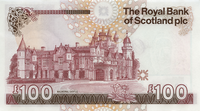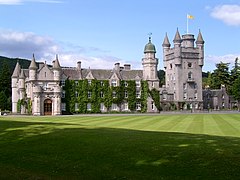The Royal Bank of Scotland £100 note
| (United Kingdom) | |
|---|---|
| Value | £100 sterling |
| Security features | Raised print, metallic thread, watermark, microlettering, see-through registration device, UV feature |
| Material used | Cotton |
| Years of printing | 1727–present 1987–present (current design) |
| Obverse | |
 | |
| Design | Lord Ilay |
| Design date | 1987 |
| Reverse | |
 | |
| Design | Balmoral Castle |
| Design date | 1987 |
The Royal Bank of Scotland £100 note is a sterling banknote. It is the largest denomination of banknote issued by The Royal Bank of Scotland. The current cotton note, first issued in 1987, bears an image of Lord Ilay, one of the founders of the bank, on the obverse, and a vignette of Balmoral Castle on the reverse.
History
[edit]The Royal Bank of Scotland began issuing £100 notes in 1727, the same year as the bank's founding. Early banknotes were monochrome, and printed on one side only. The issuing of banknotes by Scottish banks was regulated by the Banknote (Scotland) Act 1845 until it was superseded by the Banking Act 2009.[1] Scottish banknotes are legal currency and are generally accepted throughout the United Kingdom. Scottish banknotes are fully backed such that holders have the same level of protection as those holding genuine Bank of England notes. In a narrow technical sense, neither Bank of England notes nor Bank of Scotland notes are legal tender in Scotland.[2] The £100 note is currently the largest denomination of banknote issued by The Royal Bank of Scotland.[3]
The current Ilay series of banknotes was first issued in 1987.[4] These banknotes feature a portrait of Lord Ilay, first governor of the bank, on the front. Lord Ilay's image is also used as a watermark on the notes. Other design elements include the bank's coat of arms and logo, the facade of Dundas House, the bank's headquarters in Edinburgh, and a pattern representing the ceiling of the headquarters' banking hall. All of the Ilay series notes feature a castle on the back. On the reverse of the £100 note is an image of Balmoral Castle.[5]
Designs
[edit]| Note | First issued | Colour | Size | Design | Additional information |
|---|---|---|---|---|---|
| Ilay | 1987 | Crimson | 169 × 95 mm | Front: Lord Ilay; Back: Balmoral Castle |
Information taken from The Committee of Scottish Bankers website.[3]
- Design elements on the Ilay Series £100 note
-
Lord Ilay portrait (Allan Ramsay, 1744)
-
Balmoral Castle
-
Dundas House, Edinburgh
-
Banking hall ceiling
References
[edit]- ^ "Banknote History". The Committee of Scottish Bankers. Retrieved 5 June 2016.
- ^ "Scottish and Northern Ireland Banknotes Factsheet" (PDF). Association of Commercial Banknote Issuers. Archived from the original (PDF) on 30 June 2016. Retrieved 5 June 2016.
- ^ a b "Current Banknotes : Royal Bank of Scotland". The Committee of Scottish Bankers. Retrieved 5 June 2016.
- ^ "Banknotes: 8 things you might not know". The Royal Bank of Scotland. Retrieved 5 June 2016.
- ^ "Banknote Design Features : The Royal Bank of Scotland". The Committee of Scottish Bankers. Archived from the original on 2 December 2013. Retrieved 9 June 2016.




